Babylon! Blood! Beauty!
A review of last year’s records began as a search for early fall migration arrival dates. It soon devolved into a tragic tale of ancient Babylon, unfulfilled love and blood-soaked —
I’m getting ahead of myself.
The data indicated a few early American Redstarts might begin arriving as early as the last week of July. Where would be the most likely place to search for them? Several choices presented themselves. Wait. What’s this? About this time last year, we found Hummingbird Clearwing Moths (Hemaris thysbe) at Colt Creek State Park. They were feeding on thistles. Hey, thistles are blooming now. This species feeds in the daytime. Hey, that would make taking pictures a bit easier. That settles it. Set the clock early.
Hemaris thysbe. You DO, of course, remember the tale that old Roman Ovid spun about Pyramus and Thisbe, don’t you? What? You DON’T??
Ancient Babylon. The most handsome lad in the city, Pyramus, lived next door to the most desirable girl in the city, Thisbe. Their homes were connected by an adjoining wall but their parents forbid them to associate with one another. A crack in the wall allowed them to communicate and words of love grew more intense as time passed. One day, they agreed to meet under a mulberry tree at the edge of town. Thisbe arrived first but a lioness appeared, blood covering her muzzle as she had just dined on an ox. Thisbe was terrified and ran to a nearby cave, dropping her scarf under the tree. The lioness shredded the scarf, leaving blood stains from the ox on it. Pyramus showed up, saw the lioness, which ran away and discovered the blood-stained scarf. Distraught at what he thought was the demise of the fair Thisbe, he thrust his sword into his heart. Thisbe returned to find Pyramus breathing his last, took his sword and fell on it herself. Ovid tells us the blood of the ill-fated pair splashed on the ripening mulberries, which had, heretofore, been white. From then on, ripe mulberries turn dark red to symbolize the deaths of the Babylonian would-be lovers.
Now you remember!
The Hummingbird Clearwing Moth (Hemaris thysbe) was given its Latin name by Danish entomologist, Johan Christian Fabricius, in the 18th century. He apparently was a fan of Ovid. Hemaris may be from the Greek “hema” meaning blood and “thysbe” refers to Thisbe from our story. The color of the body and wing borders of the moth reminded Fabricius of the blood spilled by the lovers.
Who says science is boring?
Hummingbird Clearwing Moth (Hemaris thysbe) among the thistles. This moth averages about 1.5 inches (38 mm) in length and about the same in wingspan. (Most actual hummingbirds are nearly twice as large.)



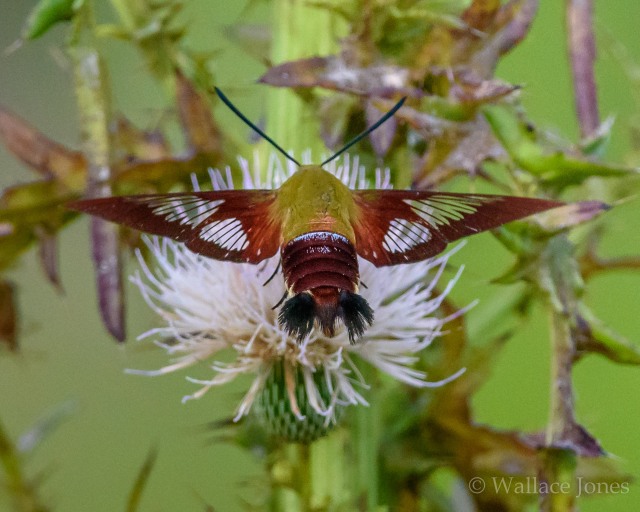
After all the drama, the remainder of our morning exploring Colt Creek State Park was rather calm. We didn’t locate any early bird migrants, but we certainly enjoyed spotting a Northern Parula singing his heart out, a gorgeous Red-shouldered Hawk, a diverse selection of insects and for a grand finale we were treated to a fishing exposition by a young River Otter.
Our tangerine breakfast was delicious but small. Time to head home for leftover okra, tomatoes and rice. Mmmmm!
Some additional Beauty! from the morning’s adventure.
A male Northern Parula wouldn’t give me a clear shot but he certainly belted out his wonderful ascending song for us!

Patrolling near a lake shoreline, a Prince Baskettail (Epitheca princeps) shows off his unique wing pattern.

The large Eastern Lubber Grasshopper (Romalea microptera) averages around two inches (55 mm) in length for males and 2.75 inches (70 mm) for females with some up to 3.5 inches (90 mm) not unusual. If nothing else, they are colorful!

The thistles (Cirsium horridulum) attract all sorts of pollinators in addition to the Hummingbird Moth. Here, a Cloudless Sulphur (Phoebis sennae) retrieves a bit of nectar.
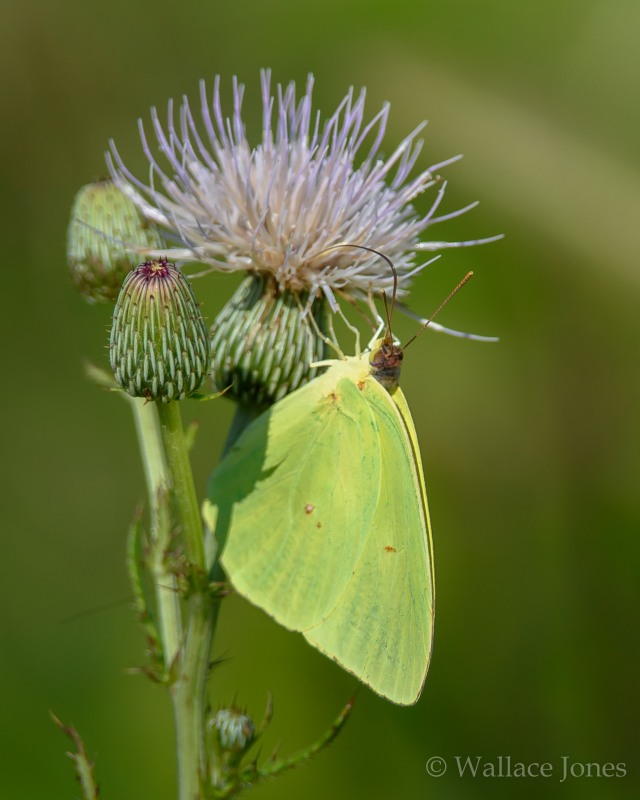
Gini spotted a Red Saddlebags (Tramea onusta) atop a spent thistle. No nectar for this lady dragon, but she has a great perch to spot potential breakfast bugs.
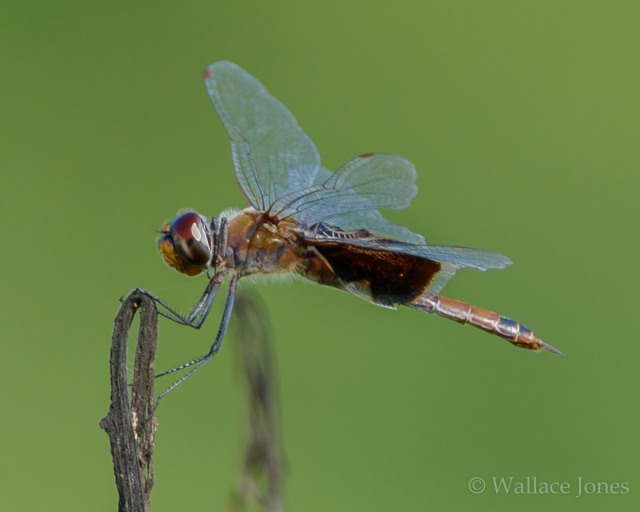
A Bumble Bee transports his cargo of pollen from one thistle to another. A quick drink for his efforts and he’s off to take a load to a different flower.
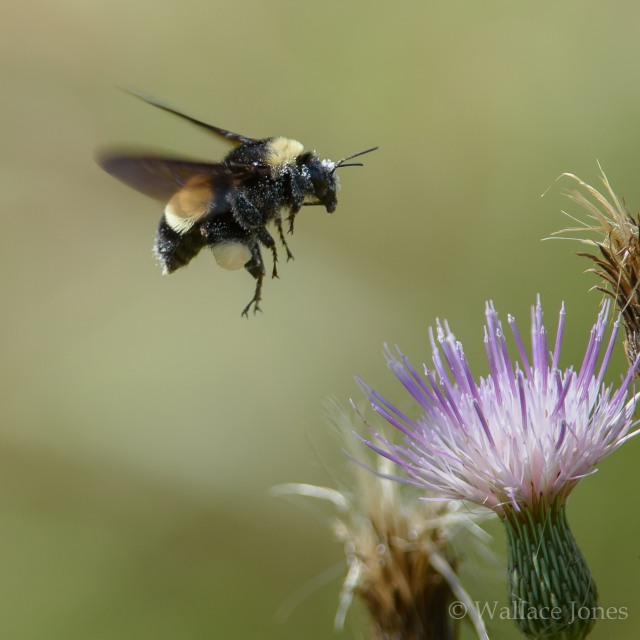
Measuring about an inch (25 mm) in length, the Black and Yellow Argiope (Argiope aurantia) is a colorful spider who usually includes a “zig-zag” design near the center of her web.

Hoping to spot a frog or a lizard, an adult Red-shouldered Hawk didn’t pay us much attention as we admired one of our most common raptors.

A Dorantes Longtail (Urbanus dorantes) has forsaken the sweet nectar of the thistles and gone over to the dark side of sampling the forbidden fruits of an invasive Brazilian Vervain (Verbena brasiliensis). No worries. He’ll be back.

Averaging 1.5-2 inches (45-55 mm), the American Grasshopper (Schistocerca americana) is sometimes referred to as the American Bird Grasshopper due to its strong flying abilities. This insect causes significant agricultural damage each year. It certainly is handsome, though!
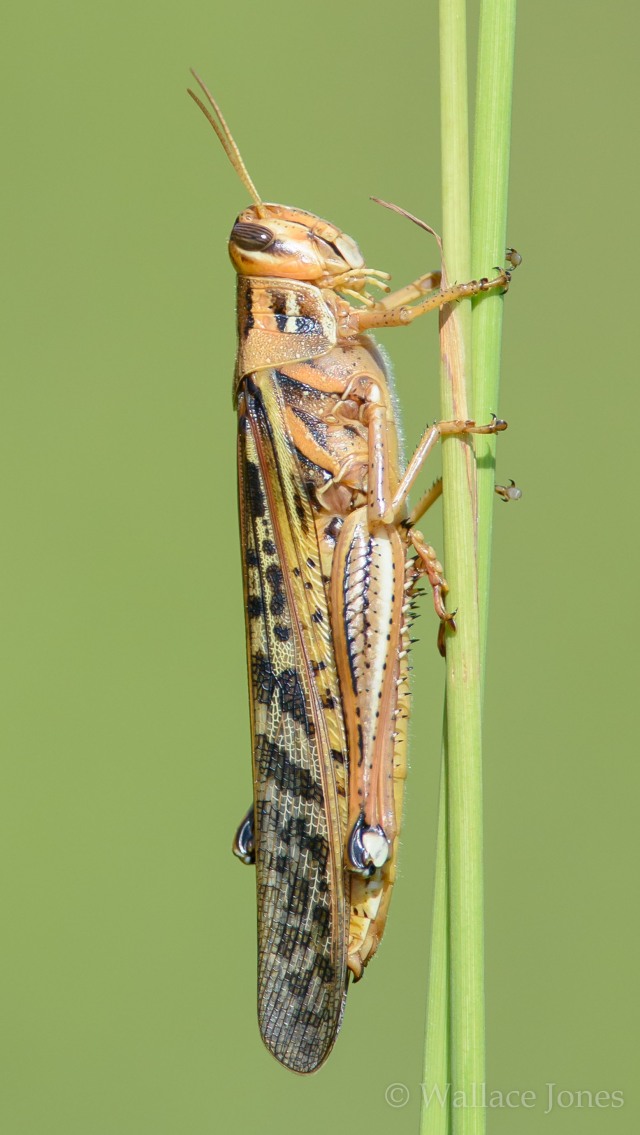
It’s hard to miss a male adult Roseate Skimmer (Orthemis ferruginea)! There isn’t much in nature with that color.

One of the smallest of the grass skippers, a Delaware Skipper (Anatrytone logan), has few markings and usually stays hidden near the ground. This one crawled onto a blade of grass for a moment – and a picture.

It’s natural to try and post nice, clear photographs of a subject in its natural environment. As a birder, I can attest that it is far more normal to see only bits and pieces of a bird most of the time! Such is the case with this Red-bellied Woodpecker who remained behind foliage and simply would not allow a decent, clear photo.

One of a half-dozen dark-colored butterflies in our area, the Black Swallowtail (Papilio polyxenes) also enjoys visiting, guess what – thistles!

The morning dew highlighted the golden glow of the wings of Needham’s Skimmer (Libellula needhami).
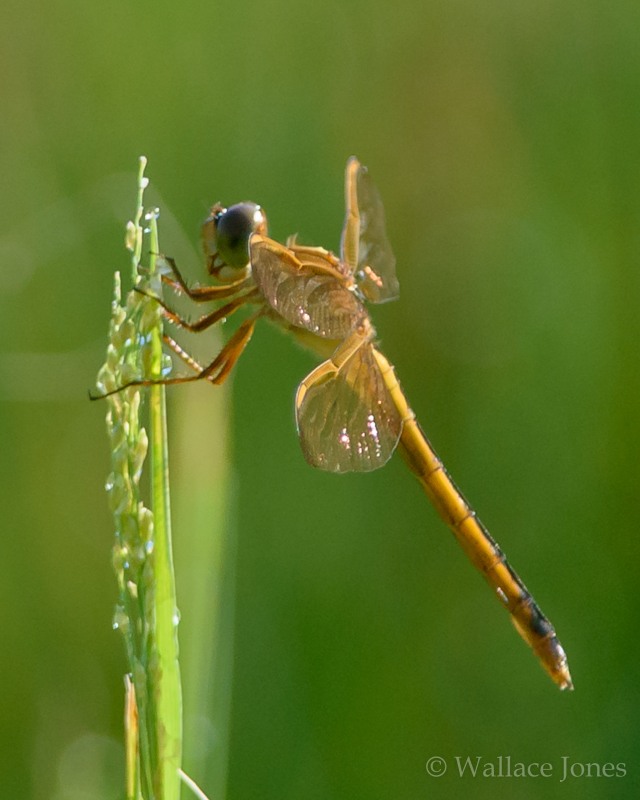
We watched this young River Otter fishing in Colt Creek for a few minutes until he realized we were there. Sploosh! A disappearing otter.

Okay, so I may have started a little over the top with dramatic license, but it was a great morning to be out in nature! Pretty neat to review old notes, make a plan to see if history would repeat and, ultimately, to enjoy success. Take a look at your own notes or photographs from this time in past years. Perhaps it will lead you to your very own Babylon! Blood! and Beauty!
Enjoy your search for a natural place and come back for a visit!
Wow!
LikeLike
Thank you very much, Saania!
LikeLiked by 1 person
So much to delight in this beautiful post, Wally. However, there were some particular highlights for me, the greatest being that header and the subsequent images of the Hummingbird Clearwing Moth. I guess you were managing some pretty fast shutter speeds to capture these so well?!
Dragons, butterflies, birds, grasshoppers, and a lesson in mythology – what more could one ask for!?
Take great care and stay safe – and remember, most of us have to pay if we want a sauna!
Best wishes to you and Gini – – – Richard
LikeLike
Once again, your very gracious comments are much appreciated, Richard!
Shutter speeds on the moth images ranged from 1/2000 to 1/4000. It was a fun morning!
We are thankful the government has not yet figured out a way to charge us for the pleasure of enjoying Florida’s “open-air sauna”! (Just give them time. They’ll come up with something.)
All our best to you and Lindsay.
LikeLike
What a wonderful array of creatures. I am stuck at home at present and I am missing being able to explore. Having said that, it does make creatures that visit your garden feel all the more precious.
Hope all is well. Stewart M – Melbourne
LikeLike
Thank you, Stewart! We are all hoping the “stuck at home” plague will begone and some semblance of normalcy will soon return.
Turns out our gardens are doing exactly what we planned on: providing a bit of solace when we need it most.
All is well here in sub-tropical, hot, humid Florida!
We wish you all the best Down Under.
LikeLike
This is all getting a little highbrow for me. I just get sorted with Latin bird names and the have to learn all about the Romans. Anyway I claim my ten dollars. You are Pyramus and Gini looks a little like Thisbe after eating a tomato pizza? In this case you both live happily ever after.
I had to look up your clearwing moth as we have something very similar, the Hummingbird Hawk Moth. Unfortunately this is very rare here in Lancashire where it is always a few degrees colder than the average temperatures 100 or 200 miles south of here in a place named “London and The South”, a mysterious region, another world, that we up here refer to in hushed tones but with a fixed smile.
Perhaps like Floridians refer to NY or DC? We do see the HHMs in the Med – hopefully in Greece soon.
Again, those grasshoppers are awesome. Such a pity those damn birds east so many.
LikeLike
No worries, Phil. My brow has already returned to its usual location and, besides, there will be no pop quiz on Roman literature.
Gini is amazed at your accuracy and is now insisting I refer to her as “The Fair Thisbe”. We are, indeed, living happily ever after. (She said thank you for the smiles!)
About that ten dollars. I tried to send it to you but couldn’t work out if it should be in Euros, Pounds or gold ingots. So I wrote a check. One day, I may post it.
We are quite pleased the damn birds consume so many grasshoppers! Otherwise, we would have no cereal or bread. That would be a tragedy.
LikeLike
I enjoy reading your blog Wally, because I always learn (or re-learn?) something. Although I have to admit I don’t recall ever hearing Ovid’s tale about Pyramus and Thisbe. Must have been one of those times I was goofing off in school.
Thistles are hard to miss when they’re blooming, but I’ve never managed to sight one of those fascinating Hummingbird Clearwing Moths. They make wonderful photo subjects.
Take care,
Ed
LikeLike
Thank you, Ed! Hard to believe such a thorny plant hosts so many beautiful creatures.
A new week is upon us!
Photo opportunities await …
LikeLike
Great outing, Wally, with pictures to prove it, and no blood-stained scarf to ponder over. Red-shouldered Hawk is uncommon here and your excellent shot reminds me of seeing them frequently the last time I was in Florida, and being pleasantly surprised at how approachable they were.
LikeLike
The ubiquitous Red-shouldered Hawk is a great example in adaptation to human encroachment. It has excelled in surviving in all habitats. They are so common here, it would be easy to overlook them as photographic subjects, so I strive not to.
Hope your weekend has been a good one and that our new week offers us all an opportunity to share what Nature has to offer!
LikeLike
Hello,
Love the Clearwing moth images. The Northern Parula is beautiful. The otter was a great find. Great nature shots! Enjoy your day! Wishing you a happy new week!
LikeLike
It was a good day. Thank you, Eileen.
LikeLiked by 1 person
All this and an otter too??? Colour me jealous.
And very grateful for the beauty you shared.
LikeLike
Any time, EC! Thank you for dropping by.
LikeLike